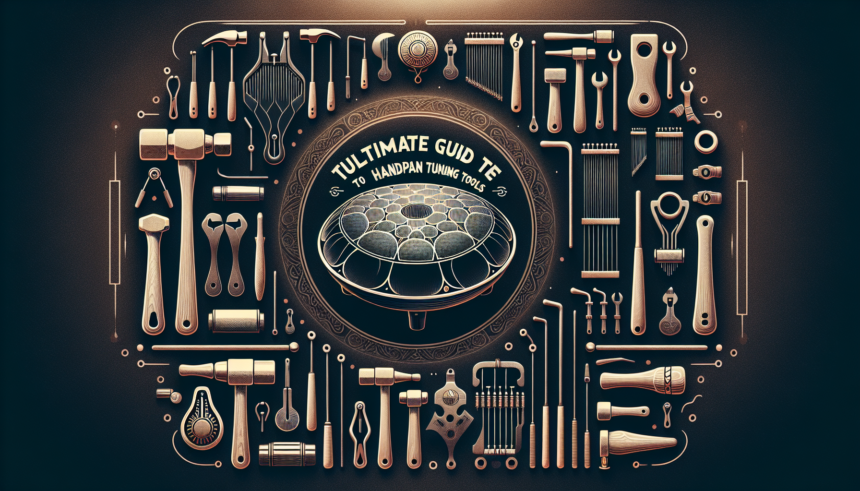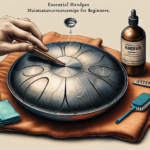<!DOCTYPE html>
<html lang="en">
<head>
<meta charset="UTF-8">
<meta name="viewport" content="width=device-width, initial-scale=1.0">
<title>Ultimate Guide to Handpan Tuning Tools</title>
</head>
<body>
<article>
<header>
<h1>The Ultimate Guide to Handpan Tuning Tools</h1>
<p>Handpans are mesmerizing musical instruments that create ethereal sounds. Proper tuning, however, is crucial for maintaining their unique tonal quality. This guide will cover everything you need to know about handpan tuning tools, from basic essentials to advanced equipment, ensuring your instrument always sounds its best.</p>
</header>
<section>
<h2>Understanding Handpan Tuning</h2>
<p>Before diving into tuning tools, it’s essential to understand the basics of handpan tuning. A handpan consists of multiple notes, each meticulously tuned to harmonic frequencies. The primary goal is to align the instrument’s notes with their intended pitches, thereby preserving its sonic integrity.</p>
</section>
<section>
<h2>Essential Handpan Tuning Tools</h2>
<p>The following tools are indispensable for any handpan enthusiast looking to keep their instrument in top condition:</p>
<ol>
<li><strong>Electronic Tuner:</strong>
<p>A good quality electronic tuner is fundamental. It helps you identify the precise pitch of each note, making it easier to spot deviations and tune accordingly. Look for tuners like the Korg CA-50 or the Peterson StroboPlus HD, which offer high accuracy.</p>
</li>
<li><strong>Tuning Hammer:</strong>
<p>This is a specialized hammer designed for subtle adjustments. It allows you to gently tap the metal surface, altering its shape to correct pitch discrepancies. Tuning hammers typically come with different heads for varied impact levels.</p>
</li>
<li><strong>Tuning Forks:</strong>
<p>Though somewhat old-fashioned, tuning forks still hold their place in handpan tuning. They offer a reliable reference pitch and can be especially useful when combined with an electronic tuner for double-checking pitches.</p>
</li>
<li><strong>Rubber Mallets:</strong>
<p>These are essential for gentle taps that require less force than a tuning hammer. Rubber mallets are crucial for making minor, non-invasive adjustments.</p>
</li>
<li><strong>Stethoscope:</strong>
<p>A stethoscope can help you hear the vibrations and subtle overtones of the handpan, especially when fine-tuning notes. This tool is particularly beneficial for advanced tuning, enabling you to catch nuances that might go unnoticed by the naked ear.</p>
</li>
</ol>
</section>
<section>
<h2>Advanced Handpan Tuning Tools</h2>
<p>For those looking to take their handpan tuning to the next level, consider investing in the following advanced tools:</p>
<ol>
<li><strong>Spectrum Analyzer:</strong>
<p>This tool offers a visual representation of the sound spectrum, highlighting frequencies, harmonics, and overtones. Software like Audacity or hardware-based devices can provide these insights, helping you make precise adjustments.</p>
</li>
<li><strong>Laser Tuner:</strong>
<p>A laser tuner uses precision technology to detect minute surface variances. It’s an advanced tool favored by professionals for its accuracy and the detailed feedback it provides on the instrument’s surface.</p>
</li>
<li><strong>Microphone:</strong>
<p>A high-quality microphone can enhance your tuning process by capturing clear, detailed audio signals. This tool is especially useful when paired with a spectrum analyzer for professional-grade tuning sessions.</p>
</li>
<li><strong>Software Tuning Apps:</strong>
<p>Several software applications are available that assist in the tuning process. Apps like TuneLab and oTuner can provide real-time feedback on pitch and frequency, making the process smoother and more accurate.</p>
</li>
</ol>
</section>
<section>
<h2>Tuning Techniques</h2>
<p>Knowing which tools to use is only part of the equation; understanding proper tuning techniques is equally vital. Here are some key approaches:</p>
<ol>
<li><strong>Isolate Individual Notes:</strong>
<p>Rather than trying to tune the entire handpan at once, focus on one note at a time. Use your electronic tuner to check the pitch, then make necessary adjustments with your tuning hammer and rubber mallet.</p>
</li>
<li><strong>Tap Lightly:</strong>
<p>When using any striking tool, always tap lightly. Heavy taps can permanently damage the instrument. The goal is to make small, incremental adjustments to fine-tune the pitch.</p>
</li>
<li><strong>Utilize Harmonics:</strong>
<p>A handpan’s unique sound is built on harmonics. Pay attention to these secondary frequencies and ensure they align with each primary note. Tuning forks and electronic tuners can help identify and correct these subtle tones.</p>
</li>
<li><strong>Regular Check-ins:</strong>
<p>Regularly check each note to ensure it remains in tune. Environmental factors like humidity and temperature can influence pitch over time, so ongoing maintenance is crucial.</p>
</li>
</ol>
</section>
<section>
<h2>Common Handpan Tuning Issues</h2>
<p>Even with the best tools and techniques, tuning a handpan can come with challenges. Here are some common issues and solutions:</p>
<ol>
<li><strong>Out-of-Tune Notes:</strong>
<p>Notes that don’t match their intended pitch are common. To fix this, use your electronic tuner to identify discrepancies and adjust with your tuning hammer or rubber mallet.</p>
</li>
<li><strong>Buzzing Sounds:</strong>
<p>A buzzing or rattling sound often indicates a structural problem. Check for any loose elements or imperfections in the metal. These issues might require professional repair.</p>
</li>
<li><strong>Inconsistent Harmonics:</strong>
<p>Harmonics that are off-key can affect the overall sound. Utilize a spectrum analyzer to identify these issues and fine-tune as needed.</p>
</li>
</ol>
</section>
<section>
<h2>Maintaining Your Handpan</h2>
<p>Beyond tuning, maintaining your handpan is necessary to extend its lifespan and preserve its sound quality. Here are some key maintenance tips:</p>
<ol>
<li><strong>Clean Regularly:</strong>
<p>Wipe down your handpan after each use to remove fingerprints and oils that can affect the metal over time. Use a soft, non-abrasive cloth.</p>
</li>
<li><strong>Store Properly:</strong>
<p>Keep your handpan in a case when not in use, and store it in a dry, stable environment. Avoid extreme temperatures and humidity fluctuations.</p>
</li>
<li><strong>Avoid Heavy Impact:</strong>
<p>Handpans are delicately crafted instruments. Avoid hitting them too hard or dropping them, as this can cause detuning or structural damage.</p>
</li>
</ol>
</section>
<section>
<h2>Conclusion</h2>
<p>Tuning a handpan requires a mix of the right tools, proper techniques, and regular maintenance. With this comprehensive guide, you are now equipped to keep your handpan in optimal condition, ensuring it continues to produce beautiful, resonant sounds. While challenges may arise, patience and practice will refine your skills and deepen your appreciation for this remarkable instrument.</p>
</section>
<section>
<h2>FAQs</h2>
<ol>
<li><strong>Can I tune my handpan by myself?</strong>
<p>Yes, with the right tools and techniques, you can tune your handpan. However, it requires patience and practice to master.</p>
</li>
<li><strong>How often should I tune my handpan?</strong>
<p>It depends on usage and environmental factors. Regular check-ups every few months are advisable to keep your handpan in good condition.</p>
</li>
<li><strong>What should I do if my handpan develops a buzz?</strong>
<p>A buzzing sound often indicates a structural issue. Inspect the instrument for any loose parts or imperfections. If the problem persists, consult a professional restorer.</p>
</li>
<li><strong>Can environmental conditions affect my handpan’s tuning?</strong>
<p>Yes, humidity and temperature fluctuations can impact the metal and affect tuning. Keeping the handpan in a stable environment is crucial for maintaining its sound quality.</p>
</li>
<li><strong>What is the best way to clean my handpan?</strong>
<p>Wipe down your handpan with a soft, non-abrasive cloth after each use to remove oils and fingerprints. Avoid using harsh chemicals or abrasive materials.</p>
</li>
</ol>
</section>
</article>
</body>
</html>Ultimate Guide to Handpan Tuning Tools

Leave a comment




